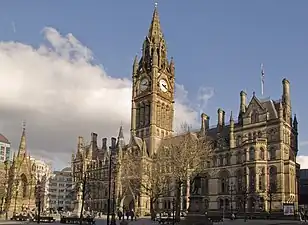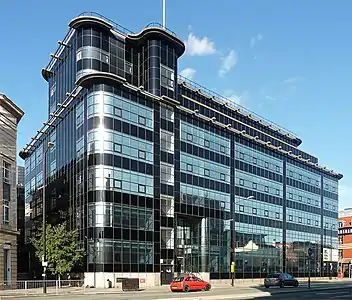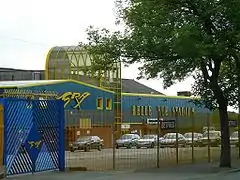 | |
| Location | Belle Vue, Manchester, England |
|---|---|
| Owned by | GRA (1926–2014) Crown Oil Pension Fund (2014–) |
| Operated by | GRA (1926–2019) ARC (2019–2020) |
| Date opened | 24 July 1926 |
| Date closed | 1 August 2020[1] |
Belle Vue Stadium was a greyhound racing track in Belle Vue, Manchester, England,[2] where the first race around an oval track in Britain was held on 24 July 1926. It has also been used for motorcycle speedway, as the home ground of Elite League team Belle Vue Aces from 1988 until 2015, and from 1999 until 2019 for stock car racing and banger racing.
The track was owned (1926–2014) and operated (1926–2019) by the Greyhound Racing Association. The Crown Oil Pension Fund bought the stadium in 2014. The stadium had luxury glass-fronted grandstands, restaurants, hospitality boxes and bars. Greyhound racing took place during three evenings including Saturday[3] and some afternoons on the Bookmakers Afternoon Greyhound Service (BAGS).[4]
Speedway
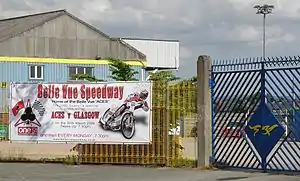
Speedway was first held at the stadium during 1928 but was not held again until 1 April 1988, when the Belle Vue Aces returned to the stadium. The team departed Kirkmanshulme Lane at the end of the 2015 season, prior to moving to the new National Speedway Stadium for the 2016 campaign. The shale speedway track was 285 metres (312 yards) in length.[5]
Greyhound racing
Origins
In 1925, Charles A. Munn, an American businessman, made a deal with Smith and Sawyer for the rights to promote greyhound racing in Britain. Although the earlier attempt to introduce mechanical racing at Hendon had almost been forgotten, the pastime of coursing was still strong in Britain. The first person Munn contacted was Major L. Lyne Dixson. The Major was a leading figure in British field sports and was quickly won over to the idea presented to him by the American entrepreneur.[6]
Finding other supporters proved to rather difficult however. With the General Strike of 1926 looming, the two men scoured the country in an attempt to find others who would join them. Eventually they met Brigadier-General Alfred Critchley, who in turn introduced them to Sir William Gentle JP. Between them they raised £22,000 and formed the Greyhound Racing Association Ltd. When deciding where to situate their new stadium, Manchester was considered to be the ideal place because of its sporting and gambling links. Close to the city centre, the consortium erected the first custom-built greyhound stadium and called it Belle Vue. The name of the stadium came from the nearby Belle Vue Zoological Gardens that had been built in 1836 and the land on which the stadium was to stand had been an area of farmland known as Higher Catsknowl and Lower Catsknowl.[6]
Opening
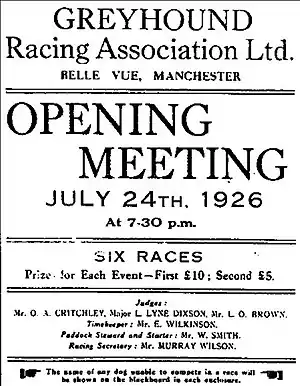
The very first race around an oval track in Britain was held on 24 July 1926. More than 1,700 people were attracted to the meeting where they watched a greyhound called Mistley win over 440 yards (402 m).[7][8]
Six races with seven dogs in each race were held in the first meeting. Fifty years later a stand was named after Mistley, the winner of the first race at 6-1 from trap one.[9] Running the quarter-mile flat course in 25 seconds, Mistley romped home eight lengths clear at 6–1.[7]
The first Director of racing was Major-General T Anderson and the first Racing Manager was L.V.Browne. Trainers included Tom Fear, Bill Brinkley & Jack Harvey. After the end of that first meeting, the GRA were horrified to find they had made a loss of £50 but as it turned out they clearly had made a good decision because 16,000 turned up the following week. The first three-month racing season saw more than 11,000 racegoers, 37 meetings and 221 races The consortium repaid a £10,000 bank loan and shares in the new company rose from their initial value of one shilling to £37–10–00 (the equivalent of £37.50 for an outlay of 5p).[10]
Going to the dogs became a national pastime and the GRA became a substantial company.
Pre-War
By June 1927, the stadium was attracting almost 70,000 visitors a week. Belle Vue increased the number of runners per race to seven, but after the formation of the National Greyhound Racing Club (NGRC) in 1928 the maximum number of dogs per race was limited to six. The phenomenal success resulted in an almost instant and dramatic mass build of greyhound stadiums. One early supplier of greyhounds to Belle Vue was Sidney Orton, a Norfolk farmer who sold 17 greyhounds to Belle Vue for £170 in 1927. Orton would eventually turn his attention to training them at Burhill kennels for Wimbledon Stadium.[11] In 1927, Bonzo, handled by Belle Vue trainer Harry Buck, was the first winner of the Grand National, known as the Champion Hurdle at the time.[12] In 1930, Belle Vue had an English Greyhound Derby finalist when Dresden trained by Eddie Wright finished fourth to none other than Mick the Miller.[13]
Belle Vue introduced the Northern Flat as their first major event in 1927. In 1930, as the sport continued as the nation's leading pastime, the GRA acquired the nearby White City track in the Old Trafford area from Canine Sports Ltd.[11] The first major Belle Vue hound was Wild Woolley; the brindle dog had won the Derby with Jack Rimmer in 1932 but switched kennels to join Jimmy Campbell. Belle Vue had 320 heated kennels housing both track's greyhounds and Wild Woolley won the Northern Flat in a world record time and the Laurels the following year before returning to Rimmer.
In 1936, Banksell won the Edinburgh Cup for John Dickenson and Genial Radiance claimed the Oaks for A.G.Hiscock. The Northern 700 was set up as a new race in 1937 joining the Northern Flat as prominent events. It was in 1937 that GRA purchased the land on which the stadium sat bringing the whole operation into their hands. Crowds continued to flock to the race meetings even as war broke out and racing was restricted to daytimes or summer.[11] Billy Butlin sat on the board of directors in 1947.[14]
1950s
In 1957, Cyril Beamount's Ballypatrick took the Scottish Greyhound Derby title and during June 1964 Belle Vue won the Greyhound Derby for the first time, Hack Up Chieftain trained by Percy Stagg and owned by S.Donohue had won a minor open at Belle Vue when watched by Brigadier General Critchley a GRA Director. Critchley suggested that the greyhound be offered the 48th and last place in that year's event. Mr W S Mulley became Racing Manager in the early fifties and would eventually be replaced by Arthur Aldridge in 1959 who in turn left to be replaced by Norman Russell in the early sixties. The track was chosen by the NGRC to host the BBC Television Trophy four times from 1961 to 1982.[15] Randy Singleton gained a trainer position taking over from Ralph Hencher in 1959.[16]
1960s
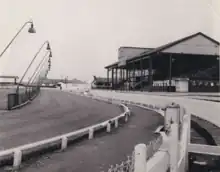
In 1961, the GRA introduced under track heating systems at Belle Vue, Harringay and White City following a successful trial in Scotland. Electric cables were basically sewn into the track by the tractor and a team of workers about eight inches under the turf. They would prove to be useful until the advent of all sand tracks. In 1971 Hall Green Racing Manager Sid Wood moved to Belle Vue and Bob Rowe (son of Leicester Racing Manager John Rowe) filled the position at Hall Green. This was the same year that the GRA experimented with eight dog racing. In fact the Northern Flat took place as an eight dog competition, the first major event to do so.[15]
1970s
The 1970s started well when Stan Mitchell was named Greyhound Trainer of the Year.[17] Following the closure of West Ham in 1972, the classic race known as the Cesarewitch was transferred to sister track Belle Vue and GRA Director of Racing Major Percy Brown retired after 40 years in the sport. It was in the seventies that Belle Vue underwent a £500,000 facelift, the previously mentioned Mistley stand was built and the track was able to offer a state of the art restaurant and tote facilities. The popular side stand was also renamed the Chieftain stand after their Derby champion.[15]
During the Silver Jubilee year of 1977 Balliniska Band trained by Eddie Moore claimed a second Greyhound Derby crown for Belle Vue and owner Raphael Bacci. Norman Porter was the Racing Manager at Belle Vue in 1983 when the White City track in Manchester closed its doors. Consequently, the Cock O’the North race was switched to Belle Vue but the Manchester Cup, a former Belle Vue event was scrapped.
1980s
Ian Travis became Racing Manager in 1987 and the Cesarewitch was moved to sister track Catford Stadium.
1990s
In 1995 but the Laurels arrived from Wimbledon in 1997.
2000-present
In 2004, the Gold Collar was hosted by the track following the closure of Catford and a few years later the original classic race the Scurry Gold Cup was brought to the track in an attempt to save the classic race.[18] The Gold Collar and Gorton Cup were discontinued. In 2018, the Oaks was given to Towcester following the decision by GRA to reduce their major race schedule.[19] During the same year the stadium signed a deal with ARC to race every Wednesday afternoon and Sunday morning.[20]
Sale and closure
In 2014, the National Asset Management Agency (who was the parent company of the GRA at the time) sold Belle Vue Stadium for £2.6 million to Crown Oil Pension Fund,[21] but agreed a leaseback to the GRA Acquisition until 2028 at a rent of £249,000 per year.[22] Mutual break options were included in the 15 year tenancy agreement. A similar lease back agreement was agreed in the sale of the Hall Green Stadium with a break clause after five years which was exercised and Hall Green closed in July 2017.[23]
In October 2019 GRA Acquisition sold the lease to the Arena Racing Company[24][25] and just two months later on 19 December housing planning permission was passed resulting in a probable closure in 2020.[26] The imminent closure came following an announcement on 1 August 2020, with the last race being run on 6 June, won by Rockmount Buster (trained by Gary Griffiths).[27] The closure was accelerated by the COVID-19 pandemic because the stadium initially closed because of the virus and then the planned re-opening only lasted one race meeting.[1] Demolition work began in May 2021.[28]
Competitions
Scurry Gold Cup
Northern Flat
Laurels
Cesarewitch
Oaks
Gold Collar
Cock o' the North
Manchester Cup
Gorton Cup
| Year | Winner | Breeding | Trainer | Time | SP |
|---|---|---|---|---|---|
| 1991 | Mr Bawn | Special Merchant – Bawnard Mona | Mick Cowley (Private) | 28.19 | 4-1 |
| 1992 | Pond Tornado | I'm Slippy – Pond Mosquito | Harry Williams (Sunderland) | 28.00 | 7-4f |
| 1993 | Watch The Bunny | I'm Slippy – Mixed Up Lady | Frank Watson (Belle Vue) | 28.06 | 4-1 |
| 1994 | Just Right Kylie | Kyle Jack – Im A Duchess | Charlie Lister (Private) | 28.30 | 2-1 |
| 1995 | White Ink | Alpine Minister – California Blue | Jimmy Gibson (Belle Vue) | 28.31 | 2-1f |
| 1996 | Burnpark Lord | Airmount Grand – Burnpark Lisa | Dave Hopper (Sheffield) | 27.78 | 7-4f |
| 1997 | Aztec Travel | Adraville Bridge – Lisnac Flyer | Nick Savva - Walthamstow | 28.36 | 3-1 |
| 1998 | Spoonbill Snowey | Right Wish – Clohast Wish | Michael Bacon (Perry Barr) | 28.59 | 11-8f |
| 1999 | Thornfield Flash | Highmoor Glen – Thornfield Sophi | Ron Coulton (Private) | 28.23 | 5-4f |
| 2000 | Farloe Cobbler | Cry Dalcash – Farloe Post | Barrie Draper (Sheffield) | 28.02 | 1-1f |
| 2001 | Forans Field | Staplers Jo – Much Better | Barrie Draper (Sheffield) | 27.81 | 9-2 |
| 2002 | Pack Them In | Spiral Nikita – Supa Score | Andy Heyes (Belle Vue) | 29.05 | 5-6f |
| 2003 | Lockup Firedice | Cushie Draco – Cushie Flair | John Mullins (Walthamstow) | 27.87 | 8-1 |
| 2004 | Holdyoursilence | Top Honcho – Misshenrietabell | Liz McNair (Private) | 27.72 | 10-1 |
| 2005 | Joes Gem | Larkhill Jo – Droopys Nancy | Otto Kueres (Belle Vue) | 27.71 | 7-1 |
| 2006* | Ballymac Rooster | Roanokee – Ballymac Pepes | Carly Philpott (Private) | 27.69 | 7-4 |
| 2007 | Manic Mile | Pacific Mile – Cute Mandie | Graham Hutt (Private) | 27.91 | 6-4f |
| 2008 | Blenhiem Dubh | Droopys Vieri – Blenhiem Queen | Julie Bateson (Private) | 27.95 | 7-4f |
| 2009 | Royal Warrior | Spiral Nikita – Axle Grease | Stuart Mason (Private) | 27.82 | 6-4f |
Northern Stayers Stakes
Formerly the Northern 700
| Year | Winner | Breeding | Trainer | Time | SP |
|---|---|---|---|---|---|
| 1937 | Sleeping Horner | Jimmy Campbell (Harringay) | 41.01 | 5-4f | |
| 1946 | Torard Rose | Ralph Hencher (Belle Vue) | 41.36 | 4-1 | |
| 1947 | Jersey Creamery | Roeside Creamery – Jersey Lily | Percy Stagg (White City, Man) | 41.58 | 9-4 |
| 1948 | Kilbelin Dancer | Bellas Prince – Kilgowan | Percy Stagg –(White City, Man) | 40.93 | 4-7f |
| 1949 | Rio Cepretta | Flying Dart – Rio Czarina | Stanley Biss (Clapton) | 40.99 | 8-1 |
| 1950 | Caledonian Faith | Train – Caledonian Desire | A Mountfield (Private) | 40.96 | 6-1 |
| 1951 | Brooklands Express | K Fraser (Belle Vue) | 41.22 | 11-2 | |
| 1952 | Malanna Mace | Henry Parsons (Crayford) | 40.88 | 1-2f | |
| 1953 | Mottram Hero | Kilrid Hero – Samsons Spider | Ralph Hencher (Belle Vue) | 40.94 | 7-4f |
| 1955 | Registered Cash | Bahs Choice – Any Cash | Percy Stagg (White City, Man) | 40.90 | 7-2 |
| 1956 | Duke Of Alva | Ballymac Ball - Marchioness Minnie | Ted Brennan (Owlerton) | 41.22 | 1-2f |
| 1957 | Baytown Drone | Ollys Pal – Baytown Button | Harry Bidwell (Owlerton) | 40.93 | 6-1 |
| 1958 | Lancewood Olly | Ollys Pal – Maggies Choice II | Ted Brennan (Owlerton) | 41.88 | 6-1 |
| 1959 | Come To Johnny | The Grand Champion – Shaggy Lake | Jack Brennan (Darnall) | 40.12 | 6-1 |
| 1960 | Finisk River | The Grand Champion – Kilahalla Peggy | Cyril Beumont (Belle Vue) | 41.80 | 2-1 |
| 1961 | Master Mac Murragh | Solar Prince – Cailin Orgha | Cyril Beumont (Belle Vue) | 41.06 | |
| 1962 | Devilment | Solar Prince – All Steel | Ron Chamberlain (Private) | 40.53 | |
| 1963 | Buckwheat | Crazy Parachute – Tornado Lass | Paddy Keane (Private) | 41.28 | |
| 1964 | Joystick | Crazy Parachute – Snowfire Lady | Harry Bamford (White City, Man) | 40.59 | 8-1 |
| 1965 | Grove Rambler | Hi There – Grove Cheerful | Harry Bamford (Private) | 41.97 | |
| 1966 | Coloured Bill | Buffalo Bill – Fast Sister | Jim Hookway (Owlerton) | 40.54 | |
| 1967 | Outcast Mad | Crazy Parachute – Stokesfield Lass | Jim Irving (Private) | 40.86 | |
| 1968 | Booked Six | Booked Out - Technician | Wilf France (Belle Vue) | 41.38 | |
| 1969 | Aughgar King | Monalee King – White May | John Horsfall (Catford) | 40.43 | 10-1 |
| 1970 | Meronome | Prince of Roses – Meteoric | Harry Bamford (White City, Man) | 40.18 | 7-1 |
| 1971 | Knock Off | Aristos – Last Pot | Harry Bamford (Belle Vue) | 39.29 | |
| 1972 | Albany Ranger | Shanes Legacy – Little Justice | Eddie Moore (White City, Man) | 40.16 | 5-1 |
| 1973 | Poor Rudolf | Movealong Santa – Light Madam | Harry Bamford (Belle Vue) | 39.80 | 7-2 |
| 1974 | Boreen Spec | 40.25 | |||
| 1975 | Moy Mona | Monlaee Gambler - Mronome | Harry Bamford (White City, Man) | 39.72 | |
| 1976 | Wow | Sole Aim – Ardnalee Gallant | Ron Saunders (White City, Man) | 39.30 | 5-2 |
| 1977 | Montreen | Moordyke Spot - Avondale | Harry Bamford (Belle Vue) | 39.25 | 4-6f |
| 1978 | Jims Image | Jimsun – Wall Tie | Andy Agnew (Perry Barr) | 39.96 | |
| 1979 | Kilbelin Ruler | Supreme Fun - Duritza | George Barnett (White City, Man) | 40.85 | |
| 1980 | Honeygar Kid | Itsachampion – Moorstown Fog | Ray Andrews (Leeds) | 40.23 | |
| 1982 | Catsrock Tiger | Hunday Champion – Lighter Side | A Smith (Private) | 39.54 | 5-1 |
| 1983 | Sugar Palm | Brave Bran – Bridgeview Star | 40.47 | ||
| 1984 | Feeling Great | Suir Miller – Single Luck | 41.36 | ||
| 1990 | Fair And Square | Game Ball – Veazie Ann | D Hicken (Private) | 40.60 | 8-1 |
1937-74 (700 yards), 1975–90 (647 metres)
Track records
Final
| Distance metres |
Greyhound | Time | Date | Notes |
|---|---|---|---|---|
| 260 | Trapstyle Jet [29] | 14.78 | 14 October 2017 | |
| 470 | Barnfield On Air [30] | 27.20 | 4 October 2007 | |
| 470 | Ballymac Ambrose [31] | 27.20 | 31 August 2019 | |
| 590 | Blakefield Jack [32] | 35.03 | 19 September 2015 | |
| 670 | Wordsandatune [33] | 40.15 | 20 August 2009 | |
| 878 | Capoley Ash [34] | 54.28 | 8 November 2011 | |
| 470 H | Platinumlancelot [35] | 27.85 | 9 June 2009 |
Previous
Post-metric
| Metres | Greyhound | Time | Date | Notes |
|---|---|---|---|---|
| 237 | Kilree Parade | 14.69 | 14 July 1984 | |
| 237 | Parliament Act | 14.25 | 8 March 2001 | |
| 237 | Laser Beam | 14.18 | 13 February 2005 | |
| 237 | Laser Beam | 14.05 | 10 May 2005 | |
| 237 | Little Flash | 14.02 | 31 July 2005 | |
| 250 | Night Runner | 14.37 | 9 May 1987 | |
| 250 | Guleen Wishes | 14.35 | 1988 | |
| 250 | Ravage Again | 14.20 | 18 May 1990 | |
| 260 | Quick Bozz | 15.23 | 8 November 2005 | |
| 260 | Hackman | 15.23 | 28 May 2006 | |
| 260 | Jetharts Here | 15.21 | 20 September 2007 | |
| 260 | Lunar Vacation | 15.12 | 1 November 2007 | |
| 260 | Boherbradda Mac | 15.07 | 31 January 2008 | |
| 260 | Abbeyside Bart | 15.06 | 23 October 2008 | |
| 260 | Pennylane Flash | 15.05 | 28 May 2009 | Scurry Gold Cup Heats |
| 260 | Centaur Allstar | 15.00 | 4 June 2009 | Scurry Gold Cup Semi-finals |
| 260 | Drumcove Lad | 14.96 | 20 October 2011 | Scurry Gold Cup Final |
| 260 hurdles | Blonde Chief | 15.76 | 26 February 2006 | |
| 460 | Balliniska Band | 27.26 | 9 April 1977 | |
| 460 | Kickham Inn | 27.26 | 15 May 1978 | |
| 460 | Hillville Flyer | 27.15 | May 1982 | |
| 460 | Fearless Mover | 27.04 | May 1982 | |
| 460 | Precious Prince | 27.99 | 1 December 1984 | Northern Flat final |
| 460 | Debbies Time | 27.74 | April 1985 | Northern Oaks final |
| 460 | Fearless Action | 27.57 | 19 October 1985 | Manchester Puppy Cup heats |
| 460 | Fearless Action | 27.56 | 24 October 1985 | Manchester Puppy Cup semi-f |
| 460 | Fearless Action | 27.51 | 17 May 1986 | |
| 460 | Fearless Action | 27.50 | 27 September 1986 | |
| 465 | Upade Joe | 27.37 | 11 May 2001 | |
| 465 | Bat On | 27.36 | 13 February 2005 | |
| 465 | Bat On | 27.34 | 10 May 2005 | Gold Collar Final |
| 465 | Moatview Lady | 27.34 | 7 August 2005 | |
| 465 hurdles | Meanus Dandy | 28.13 | 27 August 1977 | |
| 465 hurdles | Bewitching Tess | 29.34 | 15 March 1986 | |
| 465 hurdles | Distant Panther | 28.99 | 24 September 1988 | |
| 465 hurdles | Greek Commander | 28.60 | 2 August 1994 | |
| 465 hurdles | Born to Go | 28.15 | 24 July 2001 | |
| 465 hurdles | Drive Up Sam | 27.92 | 6 July 2004 | |
| 470 | Sky Blue Honcho | 28.04 | 18 August 2005 | |
| 470 | Fear Me | 27.45 | 17 September 2005 | Manchester Puppy Cup Heats |
| 470 | Geordie Parker | 27.41 | 13 July 2006 | Northern Flat Semi-finals |
| 470 | Barnfield On Air | 27.32 | 27 September 2007 | Laurels Heats |
| 470 hurdles | Taipan | 28.25 | 24 October 2006 | |
| 590 | Thunderbird Two | 35.11 | 13 November 2005 | |
| 590 | Vatican Jinky | 35.06 | 25 September 2007 | Gold Collar Final |
| 645 | Montreen | 39.25 | 9 April 1977 | |
| 645 | Fergus Rock | 40.69 | 24 July 1984 | |
| 645 | Glenbrien Smut | 40.08 | 28 September 1985 | |
| 645 | Aglish Blaze | 39.64 | 16 August 1994 | |
| 645 hurdles | January Prince | 42.00 | 14 April 1962 | |
| 647 | Drumsna Cross | 39.53 | 10 August 2000 | |
| 647 | Creamery Puzzle | 39.11 | 29 June 2004 | Cock o' the North semi-finals |
| 647 | Roxholme Girl | 39.01 | 25 November 2004 | Gold Collar Final |
| 647 | Roxholme Girl | 38.96 | 10 May 2005 | |
| 647 | Zigzag Kit | 38.95 | 18 August 2005 | Cock o' the North heats |
| 647 | Zigzag Kit | 38.85 | 23 August 2005 | Cock o' the North semi-finals |
| 647 hurdles | El Tenor | 41.09 | 18 May 1999 | |
| 670 | Roxholme Boy | 40.54 | 20 July 2006 | Cock o' the North heats |
| 670 | Calzaghe Frisby | 40.30 | 24 October 2006 | |
| 670 | Hurleys Hero | 40.18 | 9 June 2009 | Cock o' the North Final |
| 815 | Visiting Time | 50.88 | 6 September 1980 | |
| 815 | Laden Jennie | 52.30 | 15 September 1984 | |
| 853 | Scurlogue Champ | 54.78 | 21 September 1987 | |
| 853 | Scurlogue Champ | 54.62 | 28 September 1987 | |
| 853 | Decoy Lynx | 54.59 | 17 June 1994 | |
| 875 | Let Us Know | 54.50 | 23 October 2001 | |
| 878 | Roxholme Girl | 54.33 | 18 March 2006 | Television Trophy Heats |
Pre-metric
| Yards | Greyhound | Time | Date | Notes |
|---|---|---|---|---|
| 500 | Wild Woolley | 28.49 | 1932 | Northern Flat final, world record |
| 500 | Jamboree Reveller | 28.40 | 20 April 1940 | |
| 500 | Dark Hissop | 28.27 | July 1946 | |
| 500 | Newceston Ration | 28.07 | 1950 | |
| 500 | Rushton Spot | 27.73 | 21 July 1954 | |
| 700 | Congleton Lord | 40.95 | 4 May 1938 | |
| 700 | Killcoran Castle | 40.83 | 1950 | |
| 700 | Come To Johnny | 40.12 | 10 October 1959 | |
| 700 | Mighty Kern | 40.07 | 25 July 1964 | |
| 700 | Stolen Silver | August 1968 | ||
| 700 | Meronome | 39.96 | 1970 | |
| 700 | Knock Off | 39.38 | 1971 | 8 runner race |
| 880 | Tanyard Princess | 51.69 | 5 December 1959 | |
| 880 | Chantilly Lace | 51.38 | 1961 | TV Trophy final |
| 880 | Meteoric | 50.94 | 24 October 1964 | |
| 934 | Western Stream | 55.30 | 28 July 1951 | |
| 500 H | Douro | 29.45 | 26 September 1928 | National Record |
| 500 H | Moorbrook Airmouse | 29.19 | 25 July 1959 | |
| 500 H | Mystic Scamp | =29.19 | 11 August 1965 | |
| 500 H | Blue Sprite | 29.12 | 11 August 1965 | |
| 500 H | Feakles Wish | 28.92 | 1970 | |
| 700 H | Grouncil | 43.91 | 20 September 1933 | |
| 525 C | Clarehill Rambler | 30.02 | 8 August 1959 | chase |
| 525 C | Clarehill Rambler | =30.02 | 15 August 1959 | chase |
Issues
In 2008, the Sunday Times revealed that Belle Vue greyhounds had been sent for research at Liverpool Veterinary School by Charles Pickering. The Greyhound Board of Great Britain Disciplinary Committee found Pickering in breach of nine rules of racing and ordered that he be made a Warned Off person and fined the sum of £5,000.[36] An incident during 2010 raised concerns over injury rates at Belle Vue.[37] As of 2017 all injury data was made publicly available and independently verified.[38] A 2012 article by the Sunday Express alleged that the kennels of two trainers were kept in unacceptable conditions and highlighted welfare issues.[39] In 2018 licensing and inspecting trainer's kennels was changed and to be conducted through the government-approved, UKAS accredited method.[40]
See also
References
- 1 2 "Belle Vue closure confirmed". Greyhound Star. August 2020.
- ↑ "Track Search". Greyhound Board of Great Britain. Archived from the original on 25 December 2011. Retrieved 24 December 2011.
- ↑ "Racing Schedule". Love the Dogs. lovethedogs.co.uk. Retrieved 12 January 2018.
- ↑ "Form and Fixtures". Bookmakers Afternoon Greyhound Service. bagsracing.com. Retrieved 12 January 2018.
- ↑ Bamford, R & Jarvis J.(2001). Homes of British Speedway. Stroud: Tempus Publishing. ISBN 0-7524-2210-3
- 1 2 Genders, Roy (1975). The Encyclopedia of Greyhound Racing, page 61. Page Bros (Norwich) Ltd. ISBN 0-85020-0474.
- 1 2 Genders, Roy (1981). The Encyclopedia of Greyhound Racing, page 34. Pelham Books Ltd. ISBN 07207-1106-1.
- ↑ "Greyhound Racing". South Gloucestershire Gazette. 24 July 1926. Retrieved 26 October 2022 – via British Newspaper Archive.
- ↑ "Greyhound Racing's success". Manchester Evening News. 26 July 1926. Retrieved 26 October 2022 – via British Newspaper Archive.
- ↑ Genders, Roy (1990). NGRC book of Greyhound Racing, pages 44-45. Pelham Books Ltd. ISBN 0-7207-1804-X.
- 1 2 3 Genders, Roy (1981). The Encyclopedia of Greyhound Racing, page 35. Pelham Books Ltd. ISBN 07207-1106-1.
- ↑ Barnes, Julia (1988). Daily Mirror Greyhound Fact File. Ringpress Books. ISBN 0-948955-15-5.
- ↑ Dick, Barrie (1990). Greyhound Derby, the first 60 years. Ringpress Books. ISBN 0-948955-36-8.
- ↑ "Monthly Greyhound Star (Remember When 1947)". Greyhound Star. 2012.
- 1 2 3 Genders, Roy (1990). NGRC book of Greyhound Racing, pages 45-46. Pelham Books Ltd. ISBN 0-7207-1804-X.
- ↑ "Remember When Series - January 2020". Greyhound Star. 5 January 2020.
- ↑ Barnes, Julia (1991). Daily Mirror Greyhound Fact File. Ringpress Books. ISBN 0-948955-61-9.
- ↑ Hobbs, Jonathan (2007). Greyhound Annual 2008, page 182. Raceform. ISBN 978-1-905153-53-4.
- ↑ "Towcester gets the Oaks, Leger Stays at the Barr". Greyhound Star. 23 July 2018.
- ↑ "Arc Schedule Released". Greyhound Star. 21 December 2017.
- ↑ "CBRE advises on Stadia Sale". Headline Communications. Archived from the original on 28 August 2017. Retrieved 23 June 2016.
- ↑ "WIMBLEDON GREYHOUND STADIUM, PLOUGH LANE COMPARATIVE ASSESSMENT REPORT" (PDF). RPS Group. September 2014.
- ↑ Tamlyn, Jones (5 June 2017). "Hall Green Stadium to close as 90th birthday looms". birminghammail.co.uk. Birmingham Mail. Retrieved 12 January 2018.
- ↑ "ARC SECURE BELLE VUE AND PERRY BARR FROM FELTHAM". Greyhound Star. 17 October 2019.
- ↑ "BELLE VUE/PERRY BARR ACQUISITION – GBGB STATEMENT". Greyhound Star. 17 October 2019.
- ↑ "Belle Vue Planning Approved". Greyhound Star. 19 December 2019.
- ↑ "Last race result, 14.49". Greyhound Board of Great Britain.
- ↑ "Demolition begins of Belle Vue Stadium and Showcase cinema". 25 May 2021.
- ↑ "2017 track record result". Greyhound Board of Great Britain. Archived from the original on 3 January 2019. Retrieved 3 January 2019.
- ↑ "2007 track record result". Greyhound Board of Great Britain. Archived from the original on 3 January 2019. Retrieved 3 January 2019.
- ↑ "2019 track record result". Greyhound Board of Great Britain.
- ↑ "2015 track record result". Greyhound Board of Great Britain. Archived from the original on 3 January 2019. Retrieved 3 January 2019.
- ↑ "2014 track record result". Greyhound Board of Great Britain. Archived from the original on 3 January 2019. Retrieved 3 January 2019.
- ↑ "2011 track record result". Greyhound Board of Great Britain. Archived from the original on 3 January 2019. Retrieved 3 January 2019.
- ↑ "2009 track record hurdle result". Greyhound Board of Great Britain. Archived from the original on 3 January 2019. Retrieved 3 January 2019.
- ↑ "Greyhound breeder offers slow dogs to be killed for research". The Sunday Times. Archived from the original on 6 October 2014. Retrieved 5 January 2015.(subscription required)
- ↑ Qureshi, Yakub (28 April 2010). "30 injured greyhounds put down at dog track". Manchester Evening News. Retrieved 5 January 2015.
- ↑ "Injury and Retirement Data". Greyhound Board of Great Britain. Archived from the original on 16 March 2018. Retrieved 3 January 2019.
- ↑ Jeory, Ted (22 January 2012). "Dog kennels branded 'disgusting'". Sunday Express. Retrieved 7 January 2015.
- ↑ "The Greyhound Commitment". Greyhound Board of Great Britain. Archived from the original on 16 March 2018. Retrieved 3 January 2019.
